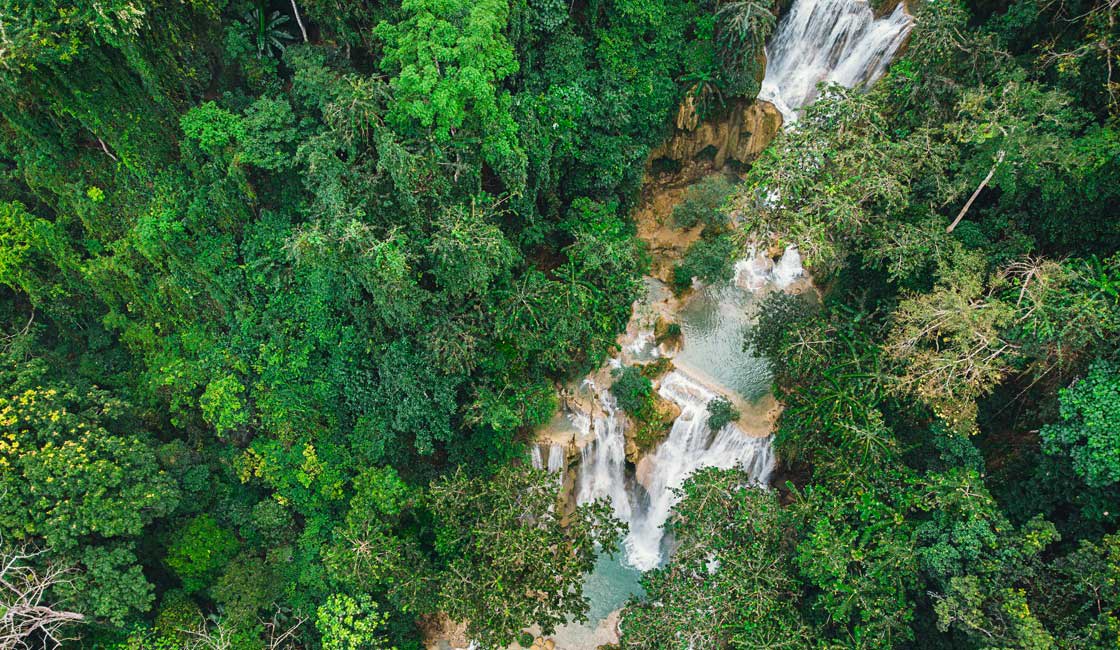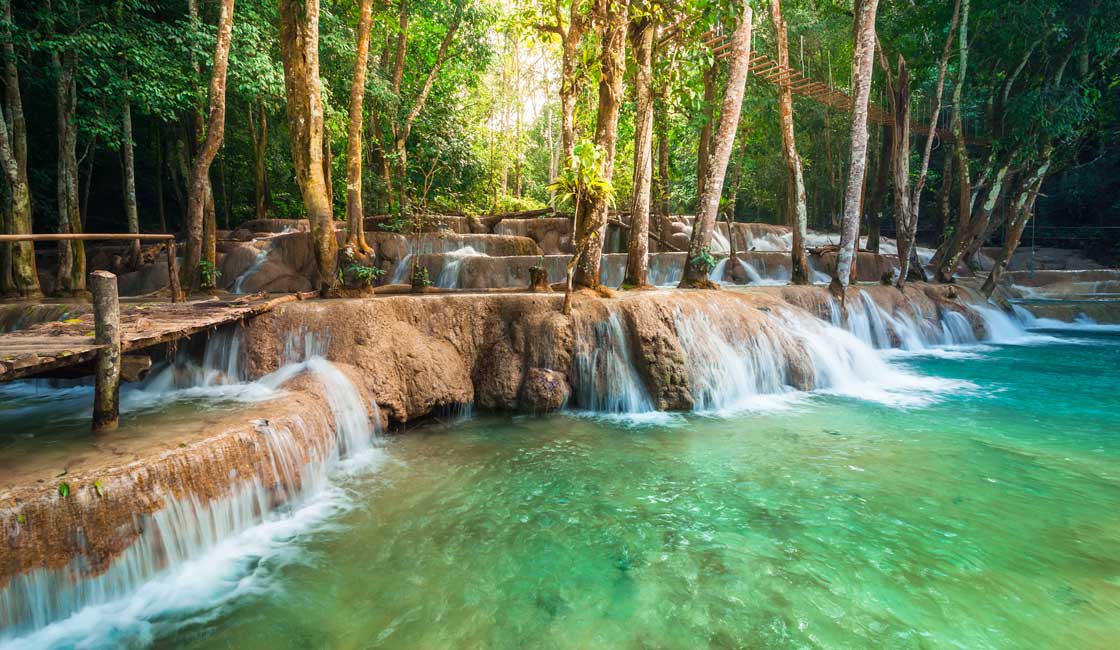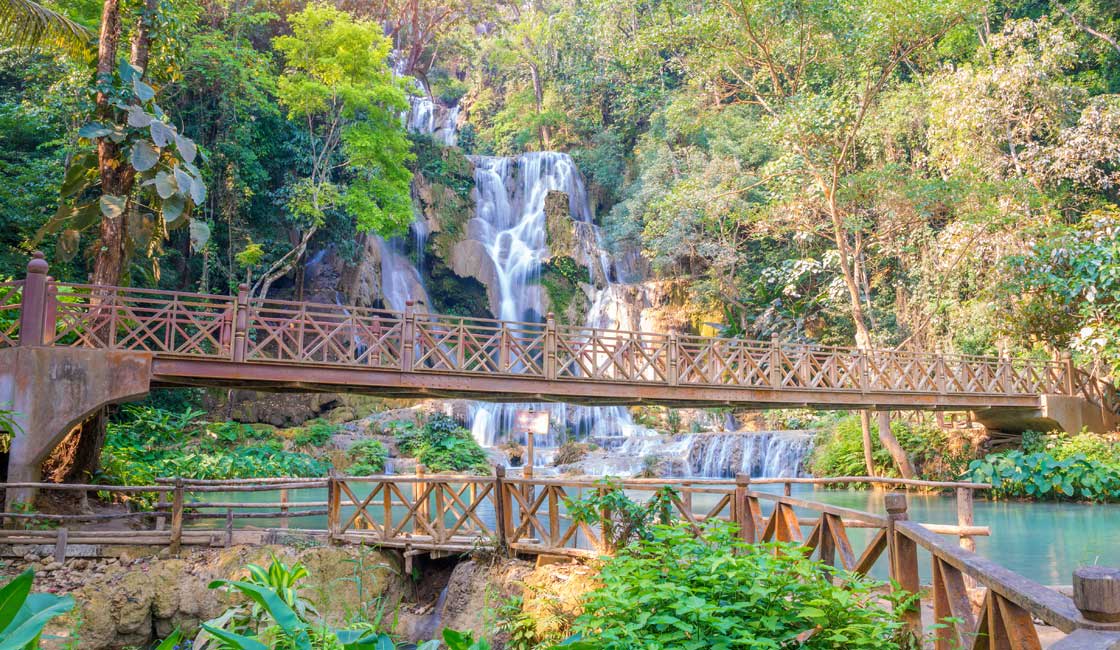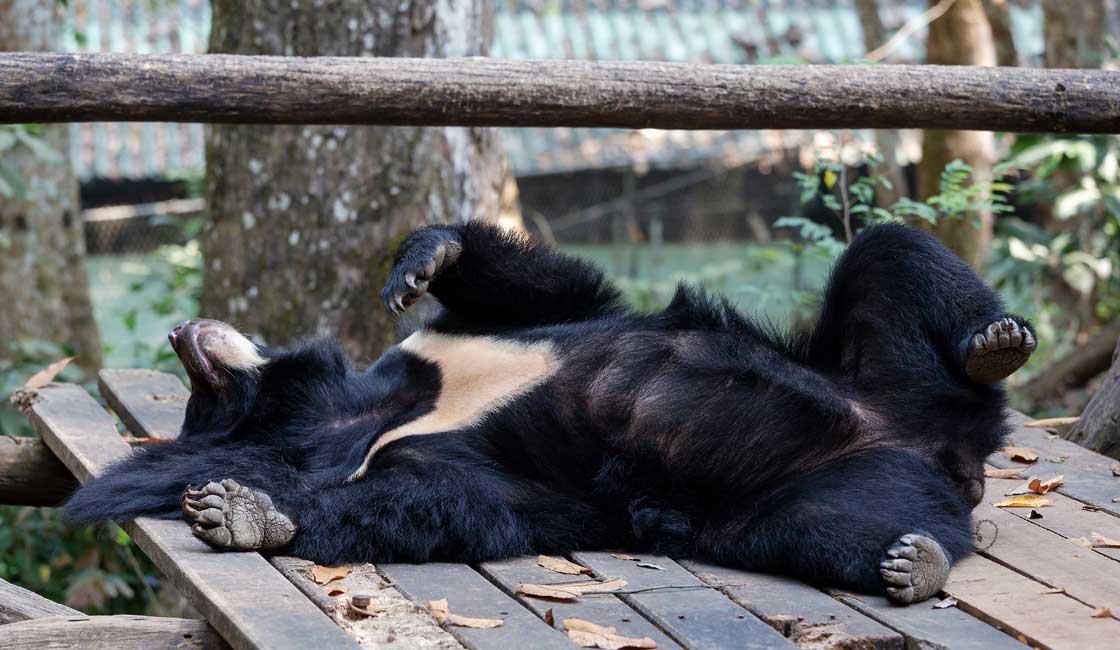
Somersaulting down through rich rainforest, the Kuang Si Falls (also known as Tat Kuang Si or Kuang Xi) is an iconic feature of Laos for good reason. A spectacular combination of turquoise waters, green jungle canopy, and dramatic waterfalls make Kuang Si Falls an ideal day trip from Luang Prabang for those who want to swim, hike or snap some once-in-a-lifetime photos.
The falls may not be as wide as the Khone Falls in Laos but are arguably the most beautiful in the country, if not the world, being made up of multiple tiers, descending from deep lagoons at the top to shallow milky-blue paddling pools at the bottom, with a tangled ribbon of smaller cascading waterfalls in between.

All bout nature
You can find the falls around 29 kilometers (18 miles) to the south of the ancient city of Luang Prabang, nestled in the heart of the Laos jungle in South East Asia. The waterfall is the largest in the region and is known as a travertine waterfall. This means it passes over a type of limestone that creates the magical milky white effect in the mineral-rich water. There are multiple different ways to get there – more on this later.
These falls really are some of the most spectacular in the world – and for once, they look as good in reality as they do in the search engine images! When you get to the site, you’ll immediately find a network of azure-blue pools bordered with little cascading rims, forming a gradual watery staircase up the hill. These pools and cascades lead to an almighty 50-meter waterfall which is the centerpiece of the whole experience and totally breathtaking.
There are, roughly speaking, three tiers of pools that work their way up to the main waterfall at the top. Take one of the trails that lead up the hill to the side of the falls and work your way up to the top. You’ll find each tier peppered with people swimming, relaxing, and jumping into the water in parts. It can get busy but the amount of tourists is not overwhelming and it depends on what time of day and season you visit in.
The formation and ambiance of each tier are different – make sure you thoroughly explore all of them! It can be tempting to jump into the shocking-blue water straight away and get settled at one of the lower pools, but our advice is to keep on up and explore the entire waterfall before chilling out in the water. This way, you can take in the entire length of the falls and check out where you want to swim or hang out.
On the way up to the top, the waterfalls between the hillside strata vary from 1 to 16 feet drops, cutting across each other in parts and creating mysterious eddies and turbulence. As you trek up through the jungle, you’ll hear the roar and trickle of the water amid the cacophonous noises of the forest.
Above the water, green fingers of forest extend, loop down, and tickle the rocky banks creating a gorgeous cool canopy overhead and on all sides. As the sun gets higher in the sky, light filters through and casts glorious patterns and colors on the water. It’s a truly magical atmosphere.

Observation spot
If you keep going past these pools, after about 15 minutes of hiking you’ll get to the main event – the stunning Kuang Si waterfall. It is a picture-perfect cascade of 50 meters high, made up of several different courses tumbling and trickling from many different levels in the yellow limestone rock to a deep dark pool below.
As you approach you’ll see a small wooden walkway that crosses the pool at a safe distance from the waterfall itself. This bridge is the closest you’ll get to the main fall – and a great spot for a photo. This means that no one has any tourists in their photos, and the waterfall is preserved sustainably.
Don’t stop – you’re not finished yet! If you keep going and keep an eye out for some hard-to-spot steps to the left of the wooden footbridge you’ve just crossed, you can find another trail that leads all the way up to the top of the waterfall. This takes roughly another 15 minutes and is well worth the effort. You will, however, have to brace yourself for steps with no hand-rail and take care of sections that are slippy with water flowing over the path.
Once you get to the top, you’re rewarded with stunning views across the forested Lao valley. After the closeness and shade of being down beneath the canopy, getting clear of the trees is invigorating. The noise of the people swimming and the roar of the waterfall has disappeared.
Here, you’ll find some tranquil pools that lead up to the edge of the cliff that the waterfall tumbles from. The water here isn’t the same color – it’s more of a muddy brown, but equally refreshing. You can glide over to the edge of the pool as if it’s an infinity swimming pool, and see for miles over the top of the jungle – even better if it’s a clear day. There’s a small picnic area here to chill at and a rope-swing. It’s the perfect spot for a break from walking before beginning the descent.

Turquoise waters of the pools
Like many places of wonder in South East Asia, there’s a story behind the name. According to legend, the water here was summoned by a wise old man who dug a hole in the ground. The water that sprung from this site was so beautiful that it caught the attention of a golden deer that came and made its home under one of the large overhanging rock formations (that was sadly destroyed in an earthquake in 2001). “Kuang” means deer and “Si” means to dig in the local dialect.
The golden deer is a popular image in South East Asian spiritual legends, featuring in the ancient Sanskrit epic The Ramayana, and also tales of Buddha’s past incarnations as a golden deer, hiding deep in the forest.
We’re often asked if you can swim at the Kuang Si Falls. Well yes, you can swim in the pools – but not all of them. There are signs by the ones where swimming is forbidden and it’s important to adhere to these rules. The waterfall is a sacred place for the local people and some parts, in particular, are considered holy.
In the sections where it is permitted, swimming in the water is glorious, and you can enjoy the rope swings and natural diving places, or simply chill out at the water’s edge if you don’t fancy getting wet. There are little wooden huts where you can change into your swimwear, near the entrance to the falls. Remember to change back out of your swimming costumes afterward before heading off the site to respect the modesty of the local culture.
At the very entrance of the waterfall site, before reaching any of the pools themselves, you’ll find the Kuang Si Bear Rescue Centre. This is run by the Free The Bears charity that operates by saving bears from terrible fates and rehousing them in safe, large enclosures.
It’s home to over 20 Asiatic Black Bears (also known as Moon Bears or White-Chested Bears) that have been rescued from poachers and other nasty fates. The Asiatic Black Bear is endangered because of its link to Chinese Medicine – their bile has historically been harvested for use in many medicinal and bathroom products. These bears could have spent their lives suspended in cages above the Mekong River before being eventually sent to Bear Bile farms.
Here, these rescued bears can roam around and enjoy life outside a cafe – you can watch them tumble about in hammocks, climb trees and play with each other. This center doesn’t take any money from the entrance fee to the waterfalls – its upkeep relies on money from t-shirt and souvenir sales and donations.

Teddies will be teddies
If you’re like most people, you’ll want to spend a full day exploring the falls and the surrounding area, so you’re bound to get hungry! You can find a local market next to the parking area by the entrance of the Kuang Si Falls site, where there are plenty of food stalls including BBQ meats and cheap but good quality Asian food. You can grab a cool and refreshing drink – Namkhong and Beerlao are local beers. There are also other stalls selling souvenirs and artisanal handicraft goods.
There are also a few restaurants around the site that are fairly pricey compared to the local food in Luang Prabang. Many people advise bringing a picnic as there are plenty of picnic tables available.

Butterflies visit the fall
If you’re looking for some other nature-based activities, you might want to check out the butterfly park that is found a few hundred meters from the falls. This site is still fairly new, founded in 2014 as a breeding sanctuary for the beautiful butterfly species of Laos.
It’s formed of a set of quaint landscaped gardens where you can wander and take in the information on offer. You can even get a mini spa treatment for your feet – and have the dead skin nibbled by fish! There’s a cafe here too, but worth remembering that this park is not open on Tuesdays.
If you appreciated the Tak Bat morning alms giving ceremony in Luang Prabang, another optional stop off on the way from the city en route to the falls is a local Hmong village which is still a traditional cultural site. The older women in the village are dressed in beautiful traditional clothing and you can browse and purchase wonderful handmade crafts here from the locals.

Pak Ou Cave
Nearly 60km away (and 25km north of Luang Prabang) are the celebrated Pak Ou Caves that look over the meeting point of the Nam Ou (Ou River) and the Mekong River at Ban Pak Ou. These are two magical caves that are full to the brim of hundreds of beautiful miniature Buddha figurines and statues.
Because this destination is water-orientated, it’s important to factor in the monsoon seasons when deciding when to travel here. The monsoon rains come between July and October, and although the falls are remarkable and at their most powerful during this time, thundering down the hillside, this is a bad time to visit. You can’t swim, hiking is too treacherous, and the waters themselves become brown with mud and lose their wonderful turquoise color.
Between December and May, the monsoon rains have truly died down and the pools are back to their gorgeous color. This is considered the best time to visit the falls as the water speed is gentler and the trails are passable. The only downside is that it is in tourist season so there are plenty of people around.
You can try to avoid the crowds if you head there on a weekday, or arrive as early as possible in the day. Generally, before 11 am is a good time to get there – midday onwards is when the place starts to fill up with people, so try and get there for the morning if you want the place to yourself.
The site is open from 8 am to 5.30 pm every day, and costs 20,000 kip (2.25 USD). There are several different ways of reaching Kuang Si Falls and we’re going to talk you through each of them so you can choose the method that suits you best. We’re assuming you’ve made your way to Luang Prabang in Laos, perhaps on an Upper Mekong River cruise.
The most popular way of getting to and from the falls is by shared tuk-tuk, also known as Songtaew. These fit 6-7 people and you can find them everywhere in Luang Prabang, and the journey takes about 45 minutes. They cost about 200,000 kip (22.4 USD) altogether, split between however many people you have in your group. This normally is the cost of the full return trip, with a few hours at the falls, but make sure you agree on this with the driver beforehand and make sure the whole group knows when to meet to make the return trip.
You can book a tuk-tuk through your accommodation the night before. It’s a good idea to round up a group beforehand either amongst friends or at your accommodation so that you don’t waste time on the day, but if you don’t have a full Songtaew’s-worth of people, the tuk-tuk driver will just wait until the vehicle fills up.
Keep an eye on the time – you don’t want to be left behind at the falls as the tuk-tuks that you can hire on site are much more expensive!
If you’d prefer to avoid the hassle of going with a group, you can take a private tuk-tuk. This independent tuk-tuk tour is a more expensive option at around 180,000 – 200,000 kip (22 – 25 USD) for the day, but it gives you much more freedom about the time you spend at the falls and lets you get there before the crowds, and spend as much time there as you like.
Your accommodation might have recommendations of reliable and fair tuk-tuk drivers for you to book with. It’s also a good idea to arrange to pay the driver after you get back to Luang Prabang if you can – this avoids them leaving you behind!
For those with a sense of adventure (and a high level of fitness!), there’s always the option of cycling to the falls on a rented bicycle. The journey is 23km by road (so a near 50km round trip), and bikes are available to rent all over the town or sometimes from your hostel or hotel. Prices are around the 20,000 kip mark (2.25 USD).
This is definitely for the hardy adventurers only – the road is not in a good condition, with bumps and potholes and plenty of dust and dirt. It’s an uphill cycle, and it can be humid in the summer.
However, it’s a totally unique way of experiencing the local surroundings, and you’ll pass by rice paddies, beautiful scenery, small dusty villages and plenty of cultures. You’ll also be so grateful for that refreshing dip in the pools when you get there! There’s also the option of cycling one way, and getting a tuk-tuk back with the bike on the roof.
You can also rent motorcycles for the day from many places throughout the town, normally costing around 20 USD per day as well as petrol costs and 2000 kip (0.22 USD) for parking at the falls.
Although this can be a fun way of experiencing the falls, it’s significantly more dangerous, as the roads are in such poor condition, traffic can be perilous and accidents happen frequently. It’s always worth having travel insurance but even more so if you’re planning a motorbike trip. Make sure to wear proper protection, and to lock it up at the other end.
Minivans run like buses, with set times for their departure and return. These public minivans cost around 60,000 kip (6.7 USD) for a seat making them another good value option and are also air-conditioned. The downsides are that because they function like buses, they make multiple stops en route to each passenger’s hotel, so it can take a while to reach the falls, and that you only get a few hours at the falls before they head back.
You can hire a private minivan or car if you have your own group ready to go. This costs around 250,000 kip (30 USD), and you’ll be in charge of your timings for the day, coming and going whenever you want to.
While Rainforest Cruises aim to provide accurate and up-to-date information, we make no representations as to the accuracy or completeness of any information herein or found by following any link on this site. Rainforest Cruises cannot and will not accept responsibility for any omissions or inaccuracies, or for any consequences arising therefrom, including any losses, injuries, or damages resulting from the display or use of this information.




